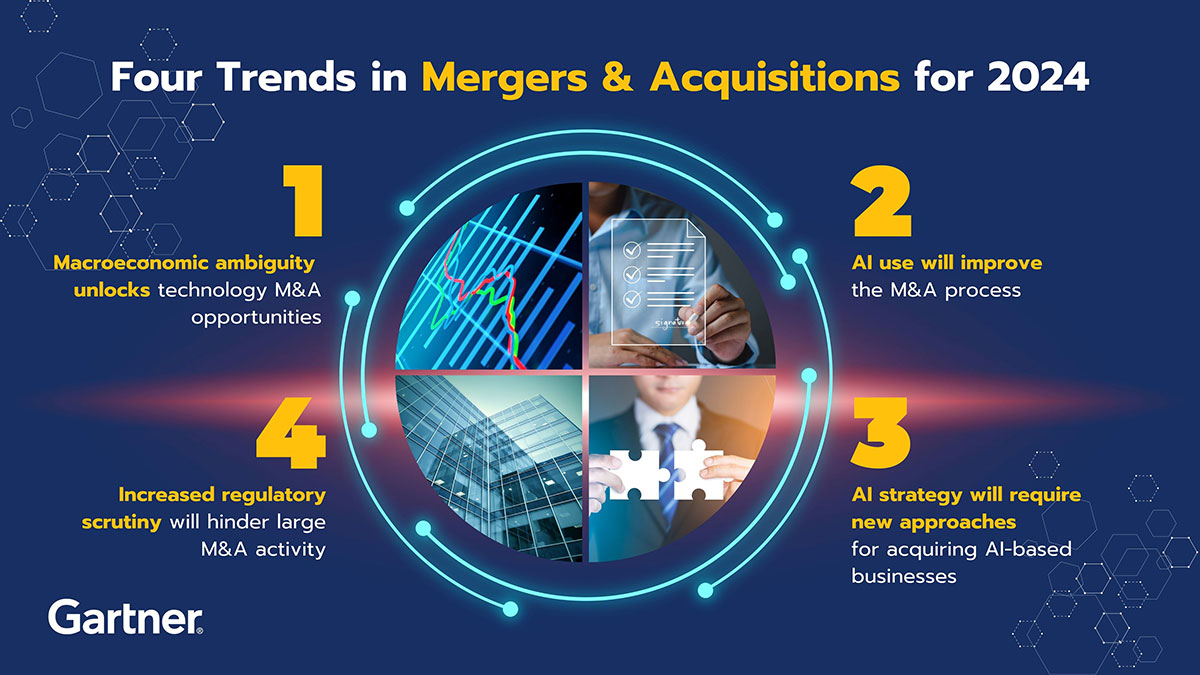Renewed Focus on Technology to Drive Reentry into the M&A Market Next Year
Gartner, Inc. has announced the top trends in merger and acquisitions (M&A) for 2024. These include unlocking technology M&A opportunities amidst macroeconomic ambiguity; using artificial intelligence (AI) to improve M&A processes; acquiring AI-based businesses; and navigating an increasingly complex regulatory environment.
“Global M&A activity is continuing its downward march from record levels in 2021, down 50% from the peak,” said Mark Carroll, VP Analyst at Gartner. “Macroeconomic and regulatory challenges reinforce the trend, but a renewed focus on technology, particularly AI, provides tailwinds for executives to reenter the M&A market in a big way next year.”
“M&A remains a growth engine for most enterprises, so next year will see success increasingly depend on how executives pivot to handle these market trends,” said Chris Ganly, VP Team Manager at Gartner. “Delivering M&A success will mean positioning their enterprises for market leadership for many years to come.”
Trend 1: Macroeconomic Ambiguity Unlocks Technology M&A Opportunities
According to Gartner, macroeconomic ambiguity will persist in 2024, with mixed positive and negative signals distorting expectations on inflation, recession, employment, cost of capital, and business and consumer confidence.
Previously expensive startup technology companies will struggle to raise their next round of venture funding and will be seeking alternatives, which includes being acquired by strategic buyers. Gartner recommends that well capitalized enterprises take advantage of this by pursuing acquisitions of smaller technology focused businesses (techquisitions) with lower valuations and less access to funding than would typically be available in clearer economic conditions.
Trend 2: AI Use Will Improve the M&A Process
The use of AI will have a profound impact on improving the speed, efficiency and overall performance of M&A processes, according to Gartner. However, the specifics of how or where AI will be used are emerging to identify what is practical now versus long-term possibilities.
Gartner recommends applying AI within internal M&A processes first by developing and testing diverse use cases. In particular, contract analytics is an impactful application for using AI right now to improve activities tied to letter of intent (LOI) negotiation, contract due diligence, definitive agreement and TSA negotiation, and contract renewals and integration.
Trend 3: AI Strategy Will Require New Approaches for Acquiring AI-Based Businesses
While M&A of AI-based businesses is not trending yet for enterprises, Gartner believes the enterprise focus on this technology will lead to a wave of deal activity in 2024. According to the 2023 Gartner CEO and Senior Business Executive Survey, AI was identified as the top disruptive technology impacting industries.
Gartner recommends the acquisition of AI businesses needs to be forefront in all business strategies in 2024. Those that lack the skills or time horizon to build capabilities on their own can use M&A to gain access to the technology.
Trend 4: Increased Regulatory Scrutiny Will Hinder Large M&A Activity
Regulatory scrutiny of M&A deals, particularly on anti-competition and national security grounds, is increasing and will continue to be a major factor hindering large M&A deals in 2024, according to Gartner. However, this trend raises the appeal of executing a large number of smaller, more industry-diverse M&A deals, which can create a competitive advantage in this environment.
“Sharper regulatory scrutiny, which can have a chilling effect on large M&A transactions, can also create a competitive opportunity for enterprises best positioned to complete a higher volume of smaller deals,” added Ganly. “For those focused on larger deals, it’s important to take a more proactive approach with regulators next year.”
พบองค์กรยังมุ่งเน้นไปที่เทคโนโลยี เพื่อกลับเข้าสู่ตลาด M&A ในปีหน้า
การ์ทเนอร์เปิดเทรนด์สำคัญของวงการการควบรวมและซื้อกิจการ หรือ Mergers and Acquisitions – M&A ในปี 2567 ซึ่งรวมถึงการปลดล็อกโอกาส M&A ทางเทคโนโลยี ท่ามกลางความคลุมเครือทางเศรษฐกิจระดับมหภาคด้วยการใช้เทคโนโลยีปัญญาประดิษฐ์ หรือ AI มาปรับปรุงกระบวนการ M&A การเข้าซื้อกิจการในธุรกิจกลุ่ม AI และสำรวจสภาพแวดล้อมของกฎระเบียบที่ซับซ้อนเพิ่มมากขึ้น
มาร์ค แครอล รองประธานฝ่ายวิจัยของการ์ทเนอร์ กล่าวว่า “การควบรวมกิจการทั่วโลกยังคงดำเนินไปอย่างต่อเนื่อง ซึ่งลดลง 50% จากจุดสูงสุดที่เป็นประวัติการณ์ในปี 2564 โดยความท้าทายทางเศรษฐกิจมหภาคและกฎระเบียบเป็นแรงเสริมของแนวโน้มดังกล่าว แต่การมุ่งเน้นไปที่เทคโนโลยีใหม่ ๆ ยังคงเป็นไปอย่างต่อเนื่อง โดยเฉพาะ AI ที่ช่วยให้ผู้บริหารสามารถพาองค์กรกลับเข้าสู่ตลาด M&A อย่างยิ่งใหญ่อีกครั้งในปีหน้านี้”
คริส แกนลี่ รองประธานทีมผู้จัดการของการ์ทเนอร์ กล่าวว่า “การควบรวมกิจการยังเป็นกลไกขับเคลื่อนการเติบโตขององค์กรส่วนใหญ่ ดังนั้นปีหน้าเราจะเห็นความสำเร็จมากขึ้นเรื่อย ๆ ซึ่งขึ้นอยู่กับว่าผู้บริหารจะปรับเปลี่ยนกลยุทธ์รับมือกับแนวโน้มตลาดนี้อย่างไร โดยความสำเร็จของการควบรวมกิจการหมายถึงการที่ผู้บริหารสามารถวางตำแหน่งองค์กรของตนให้เป็นผู้นำตลาดต่อไปได้ในอีกหลายปีข้างหน้า”
เทรนด์ที่ 1: ความคลุมเครือทางเศรษฐกิจมหภาคปลดล็อกโอกาสการควบรวมกิจการทางเทคโนโลยี
การ์ทเนอร์ระบุว่าความคลุมเครือทางเศรษฐกิจมหภาคจะยังคงมีอยู่ในปีหน้า โดยมีสัญญาณบวกและลบปะปนกัน ซึ่งส่งผลต่ออัตราเงินเฟ้อ ภาวะเศรษฐกิจถดถอย การจ้างงาน ต้นทุนของเงินลงทุน และความเชื่อมั่นของธุรกิจและผู้บริโภค
ก่อนหน้านี้บริษัทเทคโนโลยีสตาร์ทอัพที่มีมูลค่าสูงจะต้องต่อสู้เพื่อการระดมทุนรอบถัดไป และจะมองหาทางเลือกอื่น ๆ ซึ่งรวมถึงการเปิดให้เข้าซื้อกิจการโดยบริษัทขนาดใหญ่ที่มีเงินทุนและอยู่ในอุตสาหกรรมเดียวกัน หรือ Strategic Buyers การ์ทเนอร์แนะนำว่าองค์กรที่มีเงินทุนควรใช้ประโยชน์จากสิ่งนี้ โดยการเข้าซื้อกิจการธุรกิจเทคโนโลยีขนาดเล็กหรือที่เรียกว่า Techquisitions ด้วยความที่มีมูลค่าต่ำกว่าและเข้าถึงเงินทุนได้น้อยกว่าที่โดยทั่วไปมักจะเปิดให้เข้าซื้อกิจการได้ในสภาวะเศรษฐกิจสดใส
เทรนด์ 2: การใช้ AI จะเพิ่มประสิทธิภาพในกระบวนการการควบรวมและเข้าซื้อกิจการ
การ์ทเนอร์ระบุว่า การใช้ AI จะมีผลอย่างมากต่อความเร็ว ประสิทธิภาพ และประสิทธิภาพโดยรวมของกระบวนการควบรวมกิจการ อย่างไรก็ตามความเฉพาะของวิธีการและตำแหน่งที่ AI ถูกนำไปใช้นั้นกำลังเกิดขึ้นเพื่อระบุสิ่งที่ใช้ได้จริงในปัจจุบันเทียบกับความเป็นไปได้ในระยะยาว
การ์ทเนอร์แนะนำให้ใช้ AI ในกระบวนการ M&A แบบภายในก่อน โดยพัฒนาและทดสอบเคสการใช้งานที่หลากหลาย โดยเฉพาะด้านการวิเคราะห์สัญญาที่เป็นการประยุกต์ใช้ AI ที่ทรงประสิทธิภาพในตอนนี้ เพื่อปรับปรุงกิจกรรมที่เกี่ยวข้องกับหนังสือแสดงเจตจำนง สัญญาการตรวจสอบประเมินสถานะของกิจการ สัญญาหลักที่มีผลผูกพันตามกฎหมาย และการเจรจาข้อตกลงร่วมกันในการโอนย้ายธุรกิจหรือ TSA รวมถึงการต่ออายุและการรวมสัญญา
เทรนด์ที่ 3: กลยุทธ์ AI จะต้องใช้แนวทางใหม่ ๆ เพื่อควบรวมธุรกิจ AI
แม้ว่าการควบรวมกิจการของธุรกิจ AI ยังไม่ได้รับความนิยมสำหรับองค์กรต่าง ๆ แต่การ์ทเนอร์เชื่อมั่นว่าการที่องค์กรต่างมุ่งให้ความสำคัญในด้านเทคโนโลยีจะนำไปสู่การสร้างข้อตกลงหรือดีลธุรกิจมากมายในปี 2567 จากการสำรวจความคิดเห็นของซีอีโอและผู้บริหารธุรกิจของการ์ทเนอร์ ประจำปี 2566 พบว่า AI เป็นเทคโนโลยีสำคัญที่ส่งผลกระทบต่ออุตสาหกรรมที่สุด การ์ทเนอร์แนะนำว่าการเข้าซื้อธุรกิจ AI จะเป็นกลยุทธ์ธุรกิจที่สำคัญในปีหน้า ส่วนองค์กรที่ขาดทักษะหรือมีเวลาจำกัดในการพัฒนาความสามารถด้วยตนเองสามารถเลือกใช้กลยุทธ์ M&A เพื่อเข้าถึงเทคโนโลยีแทนได้
เทรนด์ที่ 4: กฎระเบียบและการตรวจสอบที่เข้มข้นขึ้นจะขีดขวางการควบรวมกิจการขนาดใหญ่
การ์ทเนอร์คาดว่า การตรวจสอบกฎระเบียบในดีล M&A โดยเฉพาะอย่างยิ่งด้านผูกขาดทางการค้าและความมั่นคงของชาติกำลังทวีความเข้มข้นเพิ่มขึ้นและจะเป็นปัจจัยสำคัญขัดขวางดีล M&A ขนาดใหญ่ในปี 2567 อย่างไรก็ตามแนวโน้มนี้กลับเพิ่มความน่าสนใจในการดำเนินการดีลข้อตกลง M&A กับบริษัทขนาดเล็กและบริษัทหลากหลายในอุตสาหกรรมจำนวนมาก ที่สามารถสร้างความได้เปรียบทางการแข่งขันในสภาพแวดล้อมนี้
“แม้การตรวจสอบกฎระเบียบที่มีความเข้มงวดขึ้นอาจส่งผลกระทบต่อธุรกรรม M&A ขนาดใหญ่ แต่สามารถสร้างโอกาสทางการแข่งขันให้กับองค์กรที่เป็นผู้นำในการบรรลุดีลขนาดเล็ก ๆ มากขึ้น สำหรับผู้ที่มุ่งเน้นดีลที่ใหญ่กว่า สิ่งสำคัญคือต้องใช้แนวทางเชิงรุกร่วมกับหน่วยงานกำกับดูแลในปีหน้า” แกนลี่ กล่าวเพิ่มเติม
